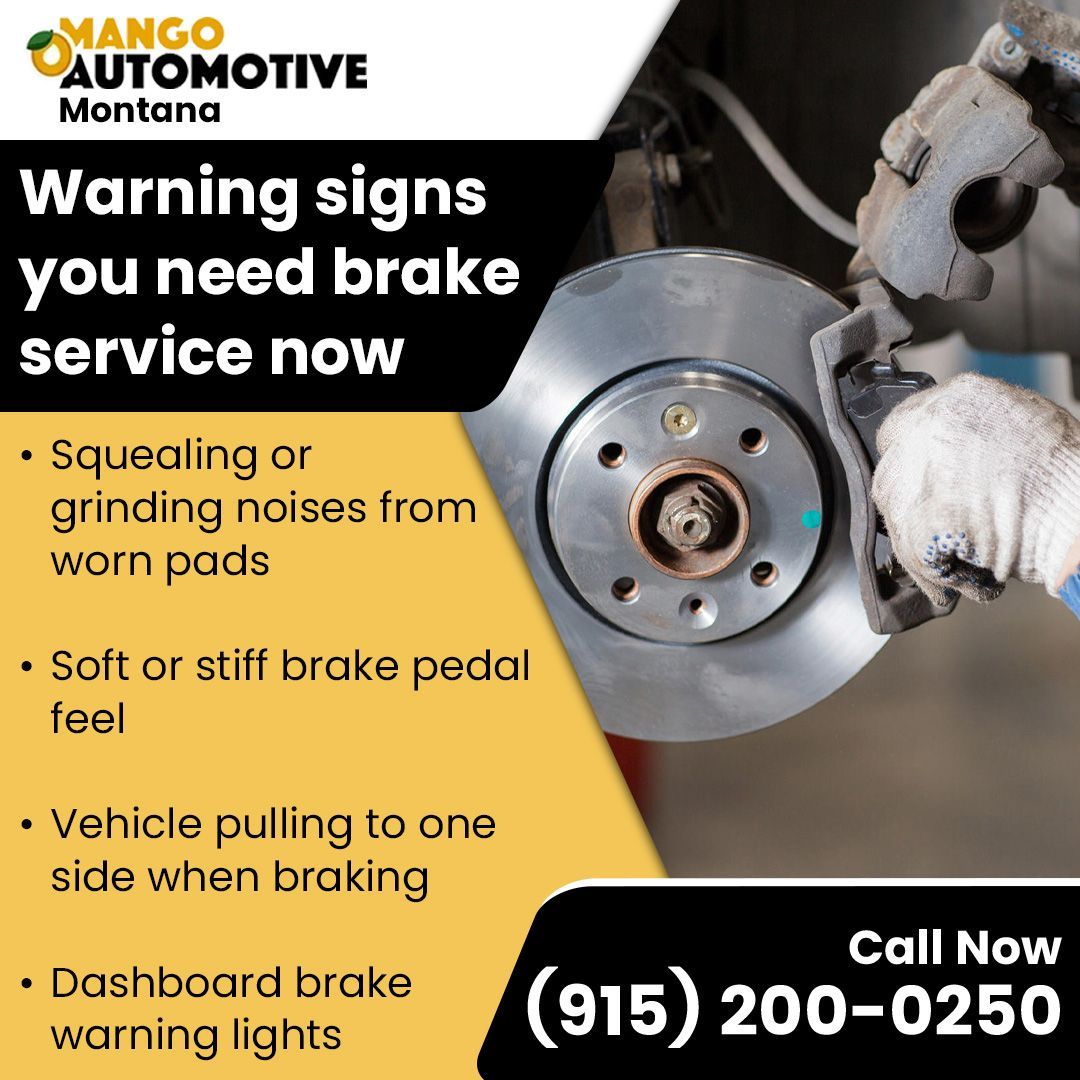Car Diagnostics Explained: How Expert Mechanics in Albuquerque Identify Problems
Car diagnostics help mechanics identify the source of a problem quickly. Most vehicles manufactured after the mid-1990s come equipped with an onboard diagnostics (OBD) system. This system monitors the engine, emissions, and other key functions. When an issue arises, it stores a fault code that a mechanic can access with a scan tool.
However, reading the code is just the beginning. While a check engine light might indicate a general issue, such as a misfire or low sensor voltage, it doesn’t always pinpoint the exact cause. That’s why diagnostic testing goes beyond simply plugging in a device. Skilled auto mechanics combine advanced tools, hands-on inspections, and real-world testing to get to the root of the problem.
In this article,
Mango Automotive will walk you through the diagnostic steps our
auto mechanics in Albuquerque take to deliver detailed and accurate results for our customers.

The Purpose of Diagnostic Checks in Vehicle Repair
Diagnostic checks help mechanics find the root cause of a car problem, not just the symptoms. Modern vehicles rely on electronic systems to manage engines, transmissions, brakes, and more. When something fails, it often triggers a warning light on the dashboard. But these alerts are general. For example, a check engine light might signal anything from a loose gas cap to a serious ignition issue.
Mango Automotive’s experienced mechanics in Albuquerque use advanced tools to retrieve trouble codes from a car’s computer. These codes act as a starting point. Then, our mechanics combine this data with inspection and test results to isolate the actual issue.
Why Diagnostics Go Beyond a Warning Light
Warning lights alert drivers, but they don’t explain the specific failure. A diagnostic code like P0300 (random misfire) can have many causes—bad spark plugs, a faulty coil, vacuum leaks, or fuel pressure problems. Relying only on the code often leads to guesswork.
That's why mechanics use additional steps like live sensor monitoring, voltage testing, and physical checks. These tests confirm whether the component flagged by the code is truly the problem or just a symptom of something else. This prevents unnecessary part replacements and gives car owners clearer answers about the repair.
Linking Symptoms to Causes Through Data
Data from the car’s onboard system connects the symptom (like rough idling) to the cause (like a failing sensor). For example:
A rough idle may link to inconsistent oxygen sensor readings.- Poor acceleration might relate to throttle position sensor data.
- Low fuel efficiency could result from a faulty mass airflow sensor.
Each symptom connects to real-time measurements stored or reported by the vehicle's systems. By comparing this data with known values, a qualified auto mechanic near you can confirm or rule out possible causes. This process is especially important for vehicles that show only changes in performance or fuel usage with no visible signs of failure.
The Step-by-Step Process Mechanics Follow
Auto diagnostics follow a structured process that begins with your input and ends with confirmed test results. At Mango Automotive, we follow this methodical approach as it helps our auto mechanics in Albuquerque avoid unnecessary repairs.
Vehicle Interview – Starting With What You Report
The diagnostic process always begins with a conversation between you and the mechanic. The first thing we’ll do is listen to your description of the problem. You’ll be asked questions like:
Does the issue occur when the engine is cold or after the car has warmed up?- Is the problem more noticeable at higher speeds or when idling?
- Did you notice any strange smells, unusual noises, or warning lights?
Your answers provide important insights, and sometimes, your observations can point directly to the issue. Our mechanics in Albuquerque use this information to narrow down possible issues, often ruling out certain systems from the very start.
Inspection Without Tools – Listening, Smelling, Looking
Our mechanics then inspect the car. Before reaching for any tools or devices, they will look, listen, and smell for anything unusual. For example, they may check for fluid leaks under the car or examine hoses, belts, and connectors for signs of wear and tear. If they hear strange engine noises or detect burnt smells, it may indicate a deeper issue, such as overheating components or electrical malfunctions.
This sensory inspection is often the first step toward identifying problems. The mechanic might immediately notice signs of leaks, engine damage, or fluid contamination, which could direct them toward a specific system. This step is important because it can confirm or eliminate initial concerns and save time before moving on to more technical diagnostics.
Electronic Scan – Retrieving Codes and Live Data
Once the initial assessment is done, our mechanics in Albuquerque use a diagnostic scan tool to connect to the car’s Onboard Diagnostics (OBD) system. This electronic scan retrieves error codes stored in the vehicle’s computer. These codes provide key information about what's going wrong. In some cases, live data from sensors is also pulled in real-time, such as readings from the fuel trim or oxygen sensors. These readings can indicate whether the engine is running too rich or too lean.
This step is essential because it directs the repair process and confirms suspicions raised during earlier steps. A scan tool can also retrieve “freeze-frame” data, which captures a snapshot of conditions when a fault occurred, providing even more context. It’s a fast way to gather critical information that guides further investigation.
Physical Testing – Verifying Suspected Faults
After gathering diagnostic codes and sensor data, physical testing is carried out to verify whether a suspected component is faulty. For example, if a mechanic suspects an engine misfire is caused by a bad spark plug or coil, they will perform a compression test or use a multimeter to test the coil’s voltage and resistance. Similarly, a mechanic may perform a smoke test to check for vacuum leaks that could affect the engine’s performance.
Physical tests like these are essential because they confirm what the diagnostics have suggested. They verify whether the code-related issue is actually caused by a malfunctioning part or system. This is a critical step that ensures only the necessary parts are replaced. This step-by-step process makes sure that all possible issues are considered and solutions are based on reliable data rather than assumptions.
What Diagnostic Results Can Reveal
Diagnostic results offer insights into the specific issues your vehicle may be facing. By analyzing the error codes and sensor data, auto mechanics can pinpoint a wide range of problems, from minor faults to more complex system failures. At Mango Automotive, we utilize these results to guide our repair decisions, ensuring your car gets the attention it needs without unnecessary part replacements.
In addition to error codes, live data from sensors such as oxygen levels or throttle position can diagnose less obvious issues. This real-time information allows mechanics to track the vehicle's performance under various conditions, aiding in the detection of issues that may not be immediately noticeable.
Single Fault vs Chain Reactions
A single fault can often trigger a chain reaction of other issues in your vehicle. For example, a failing oxygen sensor may cause the engine to run inefficiently, leading to excessive fuel consumption and possibly damaging other components, such as the catalytic converter. Similarly, a faulty alternator can lead to a dead battery, leaving you stranded without warning.
Mechanics are trained to identify these interrelated issues, ensuring that a single problem doesn’t snowball into larger, more expensive repairs down the line. At Mango Automotive, our experienced auto mechanics in Albuquerque understand how one malfunction can affect the rest of the vehicle. By analyzing diagnostic results, we can often identify and address secondary problems before they worsen.
Hidden Issues That Don’t Trigger a Warning Light
Not all vehicle problems will trigger a warning light or error code. While modern vehicles are equipped with advanced warning systems, some issues may not immediately set off alarms. For example, a slow coolant leak might not cause enough pressure drop to trigger a warning light, but could eventually lead to an engine overheating problem if left unchecked.
Some sensor malfunctions may also go unnoticed unless physical testing or manual inspections are done. Mechanics will often use their experience and diagnostic tools to uncover these hidden issues, which can prevent costly repairs later. At Mango Automotive, we focus on addressing both visible and hidden issues to make sure your car runs smoothly, whether or not a light comes on.
Errors Caused by Previous Repairs or DIY Fixes
Previous repairs or DIY fixes can sometimes lead to new errors or complications. If a part was installed incorrectly or a repair was rushed, it could cause problems that might not be immediately apparent. For example, improperly connected wiring or an incorrectly installed sensor can cause the car’s computer system to misinterpret readings, leading to further issues.
At Mango Automotive, our mechanics will carefully review past repairs and check for any signs of faulty work. Diagnostic results may reveal underlying issues caused by improper installations, providing critical context for fixing the vehicle correctly. We make sure all fixes are done right, providing long-term solutions for your vehicle.
Differences Between Basic Code Readers and Professional Tools
Basic code readers and professional diagnostic tools serve different purposes in vehicle repairs. While basic code readers are affordable and easy to use, they often provide only a brief overview of the issue by simply retrieving error codes. In contrast, professional diagnostic tools are far more comprehensive and can access deeper vehicle data, including live sensor readings and system parameters.
Why “Free Scan” Services Often Miss the Root Cause
“Free scan” services offered by many service stations or auto parts stores often fail to provide an accurate diagnosis. While these scans can identify basic error codes, they typically lack the depth required to diagnose more complex issues. A free scan might show a “check engine” light and list a code like "P0420" (catalytic converter efficiency below threshold), but it won’t explain why this problem occurred or what needs to be fixed.
These free scans often miss important details that can identify the root cause of the issue. For instance, the problem might not be the catalytic converter itself but a malfunctioning oxygen sensor or an exhaust leak that is causing inaccurate readings. At Mango Automotive, we go beyond just scanning for error codes; we interpret the data and perform diagnostics to identify the underlying issue, saving you time and money on unnecessary repairs.
How Advanced Tools Help with Intermittent Problems
Advanced diagnostic tools are essential when dealing with intermittent vehicle problems. Intermittent issues, such as occasional misfires, fluctuating engine performance, or electrical glitches, can be difficult to detect using basic code readers. These issues may only appear under specific conditions, such as when the engine is cold or the car is idling at a certain speed. This makes it harder to catch the issue during routine diagnostics.
Professional tools, however, allow mechanics to monitor live data over time, including data from sensors and critical vehicle systems. At Mango Automotive, we use these tools to capture real-time fluctuations or abnormalities that might not be noticeable during a quick diagnostic check. For example, we can use advanced tools to monitor sensor readings during a test drive, enabling us to identify problems like a faulty mass airflow sensor that only malfunctions when the engine temperature reaches a certain level. Our professional-grade tools work with a wide range of vehicle systems, ensuring a complete, accurate diagnosis.
How Mango Automotive Approaches Diagnostics
At Mango Automotive, we take a methodical and thorough approach to vehicle diagnostics. Our goal is to deliver precise, transparent, and efficient repairs to our customers. We understand that a vehicle’s health is more than just the warning lights on the dashboard.
From the moment a vehicle arrives at our shop, our mechanics in Albuquerque follow a detailed, multi-step process to make sure that all potential issues are identified. We combine expert knowledge with advanced equipment to guarantee that we don’t just focus on the immediate symptoms but also address any underlying issues that might cause future problems. This commitment to accuracy is a hallmark of our service and sets Mango Automotive apart as a trusted auto mechanic near you.
Communicating Results Clearly Without Guessing
Effective communication is key to ensuring customers understand the results of the diagnostic process. We make it a priority to explain our findings clearly and without confusion. Once we have completed the diagnostic assessment, we walk you through the report, explaining what the error codes mean, why certain parts of the vehicle may not be functioning correctly, and how the issues may affect the vehicle’s performance.
We understand that some terms and technical jargon can be confusing, so our auto mechanics in Albuquerque simplify complex information. This helps you make well-informed decisions about your vehicle's care.
Offering Repair Options with Evidence, Not Assumptions
At Mango Automotive, we offer repair options backed by evidence, not assumptions. After diagnosing the issue, we provide clear and concrete recommendations based on the data we've collected. Our team always presents you with repair options, detailing both the short-term and long-term solutions for your vehicle.
For example, if a malfunctioning part is identified, we’ll provide options based on its condition and whether it requires immediate repair or can wait for future attention. We make sure that your repairs are efficient, effective, and necessary, and that they are not based on guesses but clear, verifiable evidence from the diagnostic tools.
Choosing Mango Automotive means working with a trusted
auto mechanic near you who follows proven diagnostic and repair standards. Our focus is on delivering the right fix the first time, helping you avoid repeat visits and added costs.

Conclusion
At Mango Automotive, we understand that vehicle diagnostics are about more than just resolving warning lights. By combining expert knowledge with advanced diagnostic tools, we identify not only immediate issues but also potential future concerns.
We provide transparent and accurate information, helping you to make informed decisions about your vehicle. With our thorough diagnostic process, clear communication, and evidence-based repair options, you can trust that your vehicle is in capable hands.
At Mango Automotive, we specialize in accurate, reliable vehicle diagnostics that get to the root of the problem. Don’t wait for small issues to become big problems—call us today at
(505) 299-5011 to schedule your diagnostic check with the expert auto mechanic near you.














